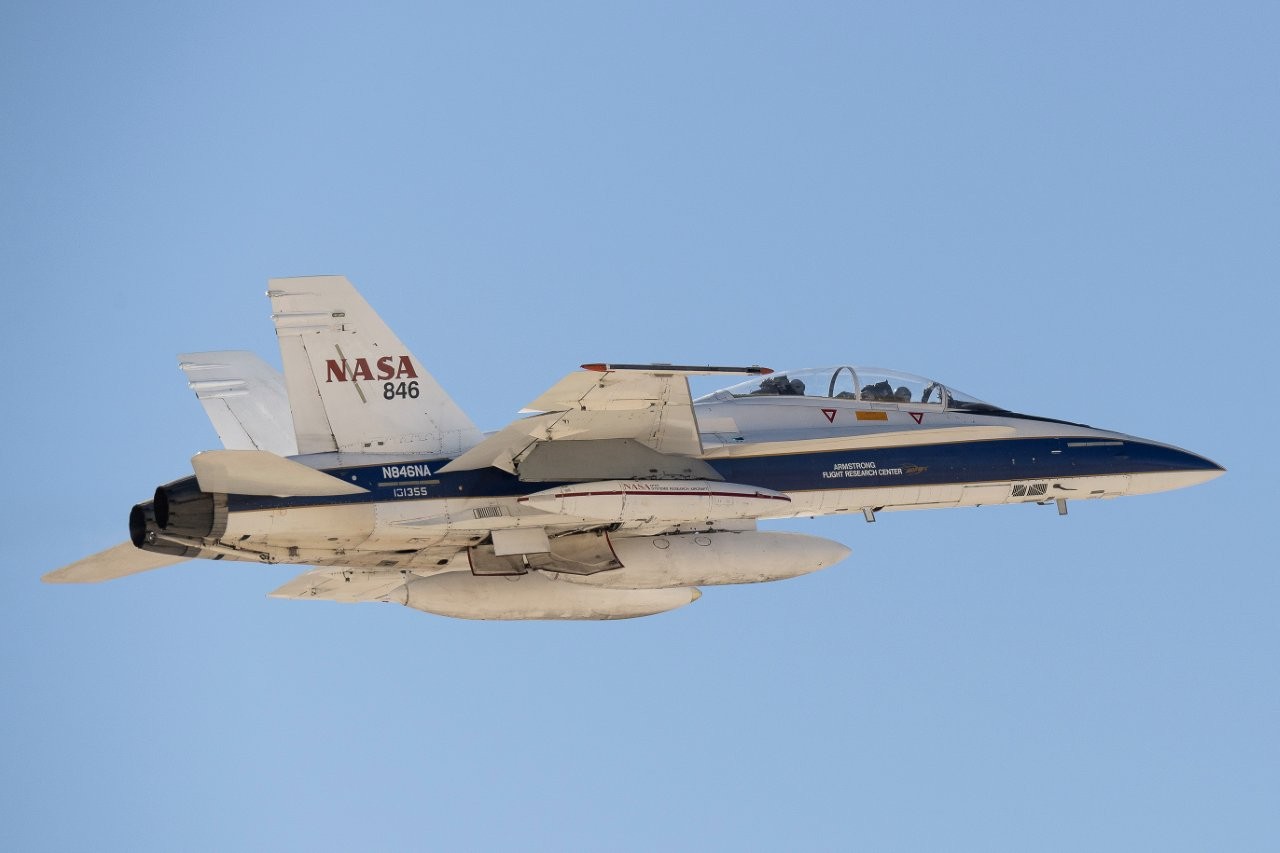2 min read
Preparations for Next Moonwalk Simulations Underway (and Underwater) A NASA F/A-18 research aircraft flies above California near NASA’s Armstrong Flight Research Center in Edwards, California, testing a commercial precision landing technology for future space missions. The Psionic Space Navigation Doppler Lidar (PSNDL) system is installed in a pod located under the right wing of the aircraft.NASANestled in a pod under an F/A-18 Hornet aircraft wing, flying above California, and traveling up to the speed of sound, NASA put a commercial sensor technology to the test. The flight tests demonstrated the sensor accuracy and navigation precision in challenging conditions, helping prepare the technology to land robots and astronauts on the Moon and Mars.
The Psionic Space Navigation Doppler Lidar (PSNDL) system is rooted in NASA technology that Psionic, Inc. of Hampton, Virginia, licensed and further developed. They miniaturized the NASA technology, added further functionality, and incorporated component redundancies that make it more rugged for spaceflight. The PSNDL navigation system also includes cameras and an inertial measurement unit to make it a complete navigation system capable of accurately determining a vehicle’s position and velocity for precision landing and other spaceflight applications.
NASA engineers and technicians install the Psionic Space Navigation Doppler Lidar (PSNDL) system into a testing pod on a NASA F/A-18 research aircraft ahead of February 2025 flight tests at NASA’s Armstrong Flight Research Center in Edwards, California.NASAThe aircraft departed from NASA’s Armstrong Flight Research Center in Edwards, California, and conducted a variety of flight paths over several days in February 2025. It flew a large figure-8 loop and conducted several highly dynamic maneuvers over Death Valley, California, to collect navigation data at various altitudes, velocities, and orientations relevant for lunar and Mars entry and descent. Refurbished for these tests, the NASA F/A-18 pod can support critical data collection for other technologies and users at a low cost.
Doppler Lidar sensors provide a highly accurate measurement of speed by measuring the frequency shift between laser light emitted from the sensor reflected from the ground. Lidar are extremely useful in sunlight-challenged areas that may have long shadows and stark contrasts, such as the lunar South Pole. Pairing PSNDL with cameras adds the ability to visually compare pictures with surface reconnaissance maps of rocky terrain and navigate to landing at interesting locations on Mars. All the data is fed into a computer to make quick, real-time decisions to enable precise touchdowns at safe locations.
Psionic Space Navigation Doppler Lidar (PSNDL) system installed in a testing pod on a NASA F/A-18 research aircraft ahead of February 2025 flight tests at NASA’s Armstrong Flight Research Center in Edwards, California.NASASince licensing NDL in 2016, Psionic has received funding and development support from NASA’s Space Technology Mission Directorate through its Small Business Innovative Research program and Tipping Point initiative. The company has also tested PSNDL prototypes on suborbital vehicles via the Flight Opportunities program. In 2024, onboard a commercial lunar lander, NASA successfully demonstrated the predecessor NDL system developed by the agency’s Langley Research Center in Hampton, Virginia.
Explore More
4 min readNASA Starling and SpaceX Starlink Improve Space Traffic Coordination
Article 15 mins ago 6 min readHow NASA’s Perseverance Is Helping Prepare Astronauts for Mars
Article 41 mins ago 2 min readNASA Cloud Software Helps Companies Find their Place in Space
Article 20 hours ago Facebook logo @NASATechnology @NASA_TechnologyShare
Details
Last Updated Mar 26, 2025 EditorLoura HallRelated Terms
Armstrong Flight Research CenterGame Changing Development ProgramSpace Communications TechnologySpace Technology Mission DirectorateTechnologyTechnology for Living in SpaceTechnology for Space Travel Read More Details
Finally We wish PressBee provided you with enough information of ( The Sky’s Not the Limit: Testing Precision Landing Tech for Future Space Missions )
Also on site :
- Food Network star Anne Burrell dies aged 55 leaving Worst Cooks in America fans devastated after show absence
- EU state pledges funds to help aspirant counter ‘Russian threats’
- Downtown Lincolnton on lockdown after 'credible threat,' police say no active shooter

